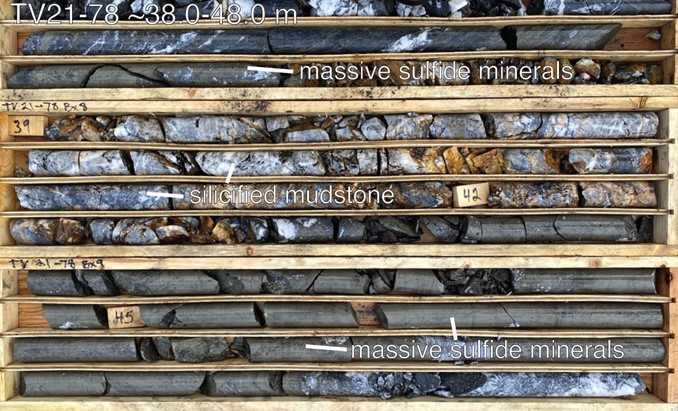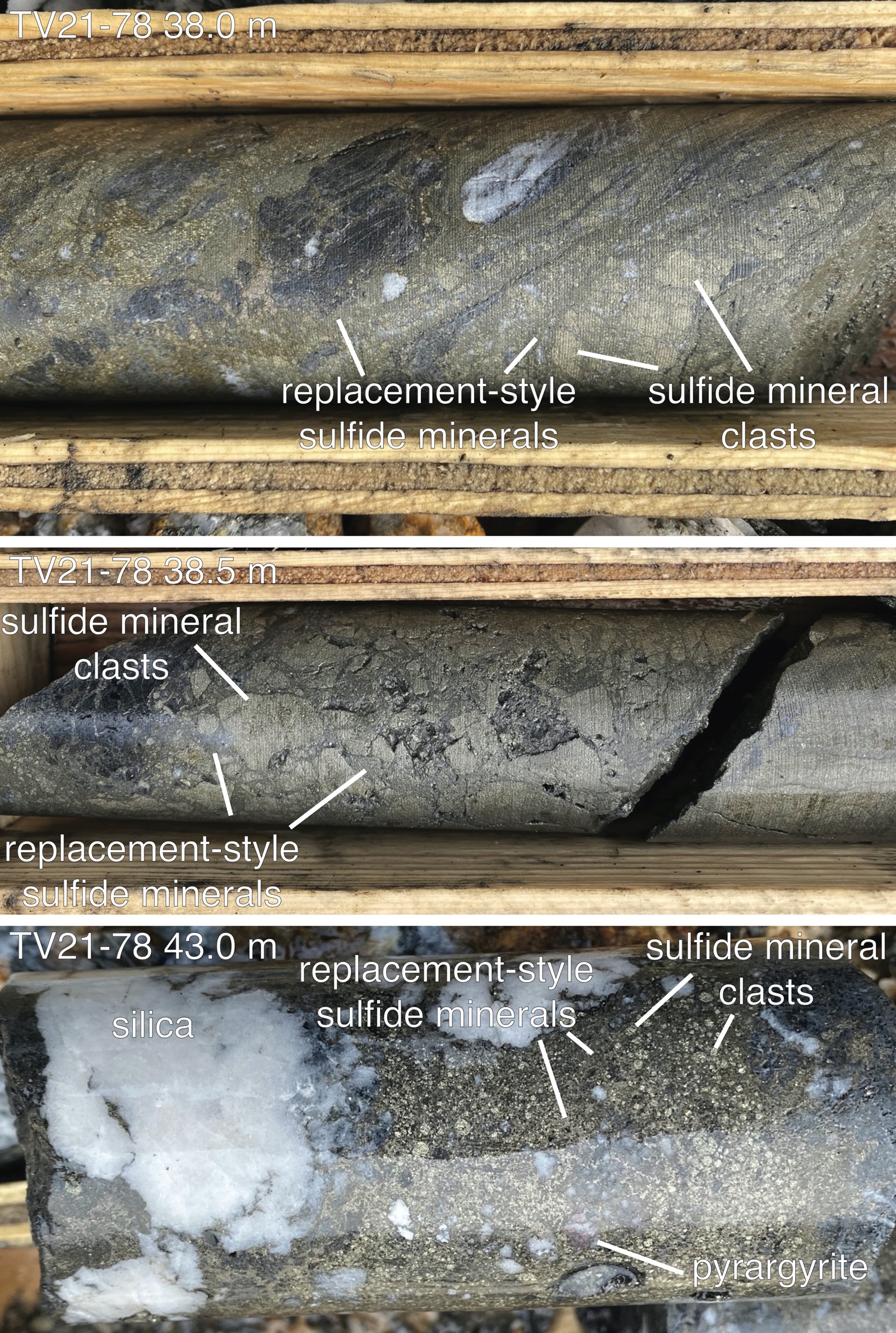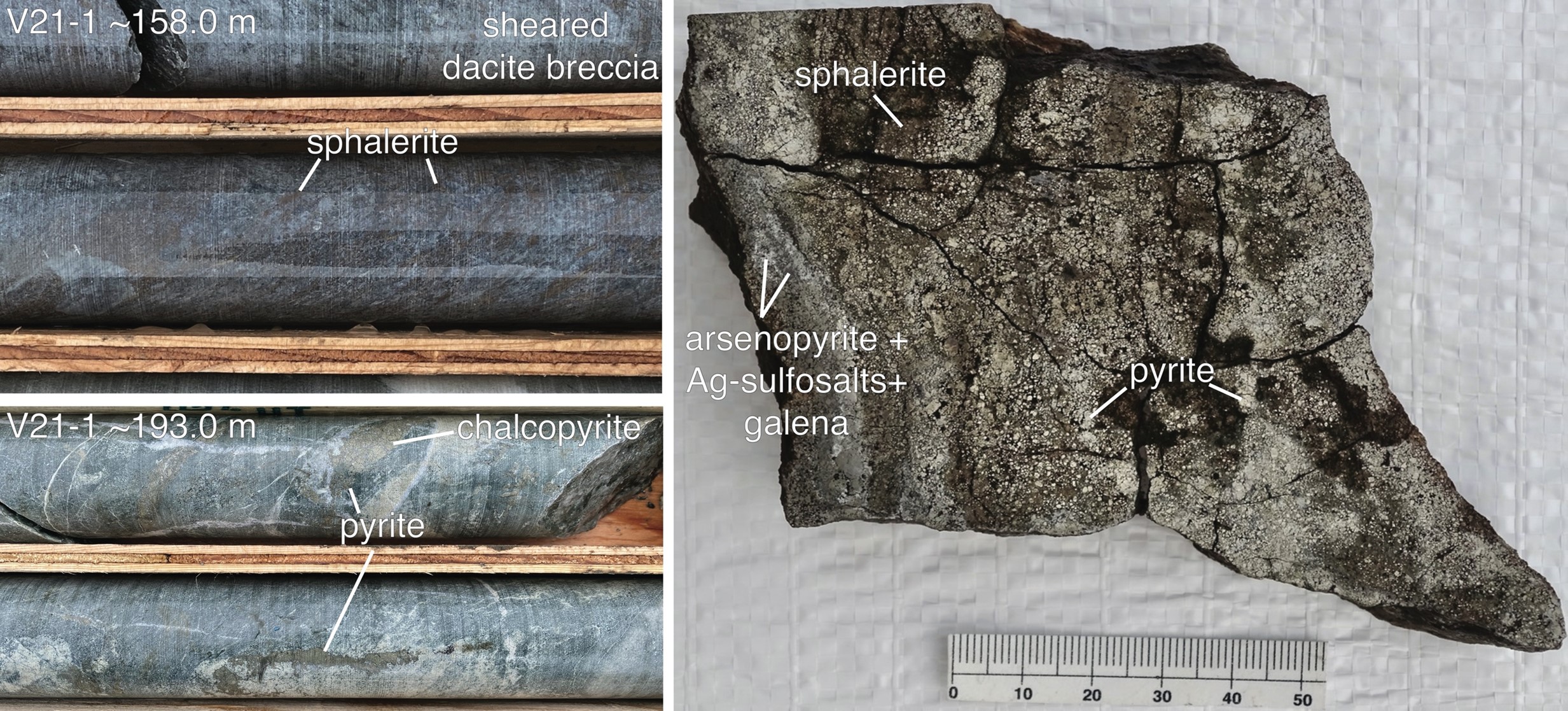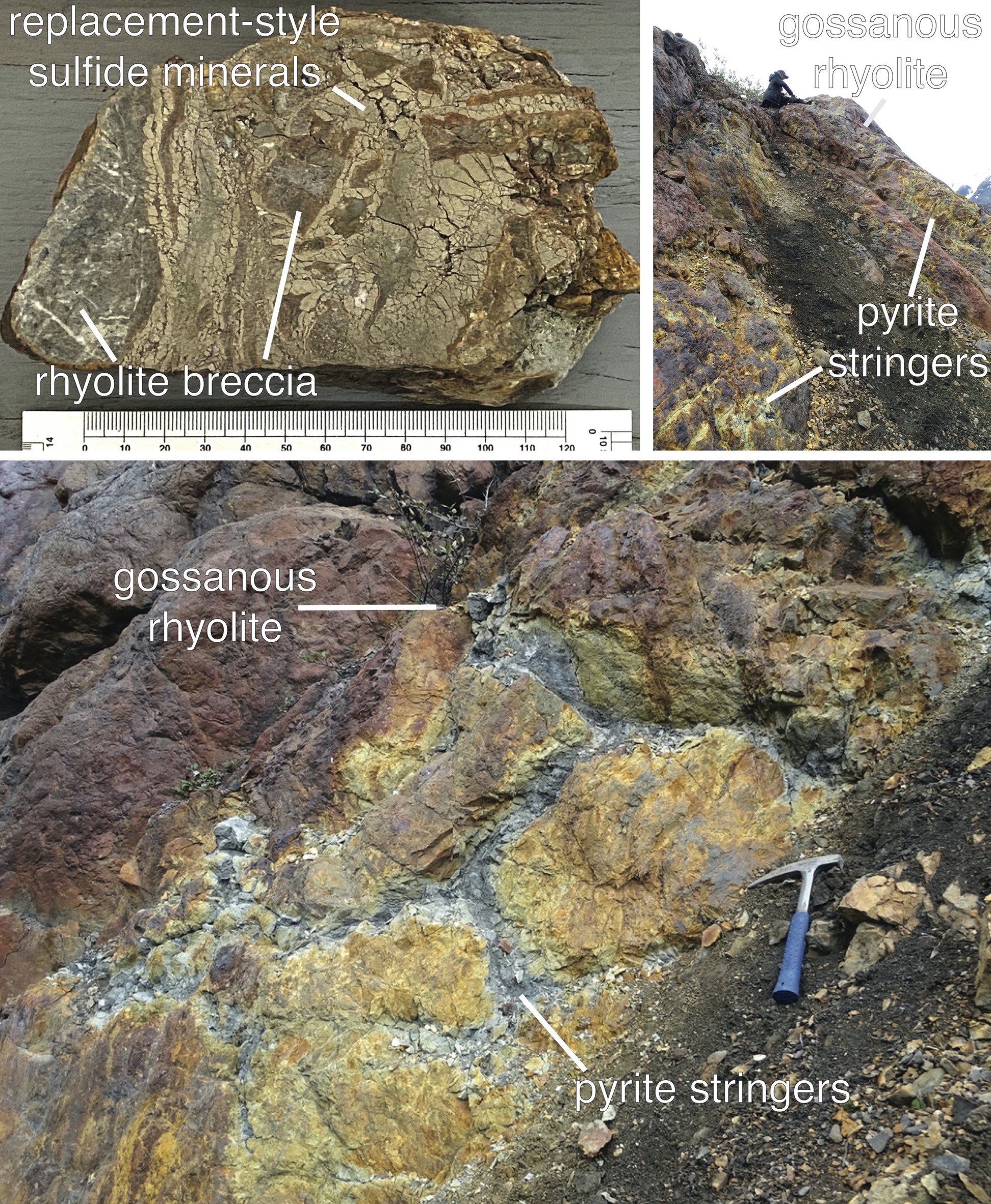TORONTO, ON / ACCESSWIRE / October 13, 2021 / Eskay Mining Corp. ("Eskay" or the "Company") (TSXV:ESK)(OTCQX:ESKYF)(Frankfurt:KN7)(WKN:A0YDPM) is pleased to announce that it has concluded its 2021 diamond drill program at its 100% owned Consolidated Eskay precious metal project in the Golden Triangle, British Columbia. Recent drilling encountered massive sulfide mineralization atop the TV volcanogenic massive sulfide ("VMS") system, demonstrates extensive sulfide mineralization occurs between the TV and Jeff deposits, confirms that the highly prospective Upper Hazelton Group stratigraphy is present in close proximity to the C10 VMS system, and establishes that the newly discovered Vermillion deposit constitutes a major new VMS discovery for Eskay Mining. In addition, ground work at Scarlet Ridge (formerly named New York; name recently changed to avoid confusion with another prospect in the area with the same name) confirms that area hosts extensive rhyolite-hosted VMS mineralization over a strike length of at least 1.5 km.
These accomplishments were made in spite of the early arrival of snow storms beginning in mid September. The Company completed approximately 23,500 meters in 98 holes, or 78% of the targeted 30,000 meter program. As announced by Eskay Mining in a Company news release dated September 16, 2021, assay turn around is expected to continue to be protracted due to an extremely active drill season in the region as well as a chronic shortage of available labor, especially at sample preparation facilities.
Summary:
- Focused drilling at TV late in the season has led to the discovery of exhalative massive sulfide mineralization at the top of what is now recognized as an extensive VMS stockwork feeder system. Discovering such a horizon was one of the top goals of Eskay's exploration team, having postulated such a deposit should be present based upon observations of increasingly altered and silicified host rocks high in this system. Massive sulfide intercepts were encountered in multiple holes (Figure 1). Sulfide minerals include pyrite, sphalerite and various silver sulfosalt phases, and clastic textures are common (Figure 2). Importantly, this newly discovered massive sulfide mineralization corresponds closely to a discrete conductive SkyTEM anomaly. Below this newly discovered massive sulfide body, multiple drill holes encountered long intercepts of intense stockwork feeder mineralization. This newly discovered massive sulfide and stockwork feeder system remain open along strike and down dip. A second, lower massive sulfide body discovered in 2020 was explored further in 2021, and is located at a distinct older seafloor position than the upper massive sulfide body. These findings confirm that TV is a stacked VMS deposit similar to those in the Noranda Camp, Quebec.
- Although the planned drill program designed to bridge the TV and Jeff deposits was cut short due to snow, one of the last drill holes completed this season, TV21-81, collared approximately 300 m north of TV and 1,700 m south of Jeff, encountered an impressive 86 m (beginning at a down hole depth of 242 m) of replacement-style sulfide mineralization hosted by dacite breccia, similar to that observed at both TV to the south and Jeff to the north (Figure 3). This discovery is important as it provides the first evidence that the TV and Jeff VMS systems may be part of one larger mineralizing system. Importantly, this newly discovered sulfide mineralization corresponds closely to another discrete conductive SkyTEM anomaly, one of several occurring along strike between TV and Jeff.
- Late season drilling at C10 encountered Upper Hazelton Group stratigraphy consisting of the Willow Ridge mafic unit and, importantly, the Eskay Rhyolite along with intervals of carbonaceous mudstone. This drilling also confirms that these rocks, the host rocks for the Eskay Creek deposit situated approximately 20 km to the north, occur on the east limb of the Eskay anticline. This is the first confirmation that these critical host rocks are present in this region.
- Several drill holes completed at the newly identified Vermillion VMS target encountered intercepts of several tens of meters of stockwork sulfide mineralization in highly chlorite-altered volcanic rocks (Figure 4). Significant sphalerite, galena, and chalcopyrite are present indicating this system is notably enriched in base metals. Arsenopyrite and silver sulfosalt minerals are observed in outcropping massive sulfide mineralization. These long mineralized intercepts coupled with extensive outcropping massive sulfide mineralization confirm that Vermillion represents a major new VMS discovery for Eskay Mining.
- Several days of ground reconnaissance at Scarlet Ridge have confirmed discovery of a major new VMS system within a cluster of very strong stream sediment BLEG Au anomalies. Stockwork to semi-massive sulfide mineralization is hosted within extensive rhyolite sills occurring in carbonaceous mudstone (Figure 5). Boundaries between rhyolite and mudstone are typically intermingled, a texture referred to as peperitic, indicating a seafloor proximal setting where unconsolidated soft mud was intruded by rhyolite sills. It is presumed that the VMS hydrothermal system exploited the same syn-volcanic feeder structure that fed the rhyolite sills. Mineralization at the Eskay Creek deposit approximately 7 km west of Scarlet Ridge is also closely associated with rhyolite sills.
With completion of drilling, Eskay has delivered a total of nearly 250 batches of core samples to the laboratory. Assay turn around is expected to continue to be protracted due to an extremely active drill season in the region as well as a chronic shortage of available labor, especially at sample preparation facilities.
"Eskay's exploration team led by Dr. John DeDecker has accomplished a long list of goals this season," commented Quinton Hennigh, director and technical advisor to the Company. "Discovery of massive sulfide mineralization atop the TV VMS system and sulfide mineralization in between TV and Jeff are a great way to end the drill season. On top of this, recent drilling has confirmed that Upper Hazelton Group stratigraphy, like that at the Eskay Creek deposit nearly 20 km to the north, is in close proximity to the C10 VMS deposit. Drilling also demonstrates that the newly discovered Vermillion deposit constitutes a major new VMS discovery for Eskay Mining. Last but not least, reconnaissance ground work confirms that Scarlet Ridge hosts an extensive VMS mineralization system associated with rhyolite intrusions over a strike length of at least 1.5 km. We are delighted with this season's accomplishments and look forward to seeing assays from drilling, rock chip sampling and soils programs."
Dr. Quinton Hennigh, P. Geo., a Director of the Company and its technical adviser, a qualified person as defined by National Instrument 43-101, has reviewed and approved the technical contents of this news release.
About Eskay Mining Corp:
Eskay Mining Corp (TSX-V:ESK) is a TSX Venture Exchange listed company, headquartered in Toronto, Ontario. Eskay is an exploration company focused on the exploration and development of precious and base metals along the Eskay rift in a highly prolific region of northwest British Columbia known as the "Golden Triangle," approximately 70km northwest of Stewart, BC. The Company currently holds mineral tenures in this area comprised of 177 claims (130,000 acres).
All material information on the Company may be found on its website at www.eskaymining.com and on SEDAR at www.sedar.com.
For further information, please contact:
Mac Balkam
President & Chief Executive Officer
T: 416 907 4020
E: Mac@eskaymining.com
Neither the TSX Venture Exchange nor its Regulation Services Provider (as that term is defined in the policies of the TSX Venture Exchange) accepts responsibility for the adequacy or accuracy of this release.
Forward-Looking Statements: This Press Release contains forward-looking statements that involve risks and uncertainties, which may cause actual results to differ materially from the statements made. When used in this document, the words "may", "would", "could", "will", "intend", "plan", "anticipate", "believe", "estimate", "expect" and similar expressions are intended to identify forward-looking statements. Such statements reflect our current views with respect to future events and are subject to risks and uncertainties. Many factors could cause our actual results to differ materially from the statements made, including those factors discussed in filings made by us with the Canadian securities regulatory authorities. Should one or more of these risks and uncertainties, such as actual results of current exploration programs, the general risks associated with the mining industry, the price of gold and other metals, currency and interest rate fluctuations, increased competition and general economic and market factors, occur or should assumptions underlying the forward looking statements prove incorrect, actual results may vary materially from those described herein as intended, planned, anticipated, or expected. We do not intend and do not assume any obligation to update these forward-looking statements, except as required by law. Shareholders are cautioned not to put undue reliance on such forward-looking statements.

(Figure 1: Core from approximately 38-48 m in hole TV21-78 showing massive sulfide mineralization and associated silicified mudstone. This is one of several holes that encountered exhalative and clastic massive sulfide atop the TV VMS system.)

(Figure 2: Close up images of massive sulfide core from hole TV21-78. Sulfides include pyrite, sphalerite and silver sulfosalts including pyrargyrite. Clastic textures are common, with the space between pyrite clasts infilled by pyrrhotite, chalcopyrite, sphalerite, and pyrargyrite.)

(Figure 3: Core from hole TV21-81, drilled approximately 300 m north of TV, showing replacement-style sulfide mineralization in dacite breccia. Such mineralization is observed at both TV, to the south, and Jeff, to the north. Eskay is hopeful that this mineralization will ultimately prove to connect the TV and Jeff systems.)

(Figure 4: Left top and bottom, stockwork feeder sulfide mineralization displaying sphalerite and chalcopyrite in chlorite-altered volcanic rocks encountered in drilling at Vermillion. Right, a polished slab from outcropping mineralization displaying massive sphalerite, galena, arsenopyrite, pyrite and silver sulfosalt minerals.)

(Figure 5: Upper right and bottom, outcrops of sulfide mineralized rhyolite at Scarlet Ridge, part of a recently discovered 1.5 km long VMS system. Upper left, slab of sulfide stockwork and replacement mineralization hosted by rhyolite breccia from Scarlet Ridge.)
SOURCE: Eskay Mining Corp.
View source version on accesswire.com:
https://www.accesswire.com/667820/Eskay-Mining-Concludes-Drill-Program-at-Its-Consolidated-Eskay-Precious-Metal-Rich-VMS-Project-Discovers-Massive-Sulfide-Atop-the-TV-Deposit












